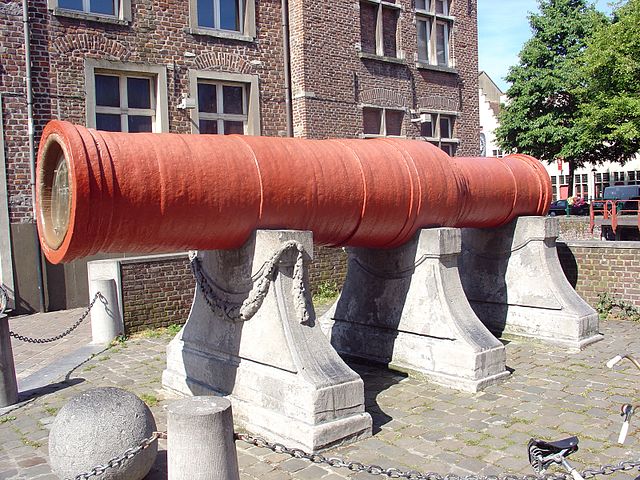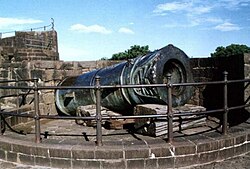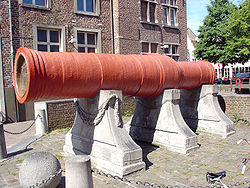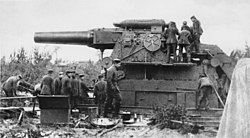Top Qs
Timeline
Chat
Perspective
List of the largest cannon by caliber
From Wikipedia, the free encyclopedia
Remove ads
This list contains all types of cannon through the ages listed in decreasing caliber size. For the purpose of this list, the development of large-calibre artillery can be divided into three periods, based on the kind of projectiles used, due to their dissimilar characteristics, and being practically incommensurable in terms of their bore size:
- Stone balls: Cannon of extraordinary bore, which fired stone balls, were first introduced at the turn of the 14th to 15th century in Western Europe. Following a logic of increasing performance through size, they had evolved from small handguns to giant wrought-iron or cast-bronze bombards within a span of just several decades.[1]
- Iron balls and shot: By the 16th century, however, a general switch from stone balls to smaller, but much more effective iron projectiles was in full swing. This and the parallel tendency towards standardized, rapid-firing cannon made the enormously costly and logistically demanding giant guns soon obsolete in the European theatre (with the exception of the odd showpiece).[2]
- Explosive shells: In the Industrial Age, artillery was again revolutionized by the introduction of explosive shells, beginning with the Paixhans guns. Breakthroughs in metallurgy and modes of production were followed up by new experimentation with super-sized caliber weapons, culminating in the steel colossi of the two World Wars. In the post-war era, the development of extremely overpowered artillery was gradually abandoned in favour of missile technology, while heavy guns are still demanded by various arms of the service.

The list includes only cannons that were actually built, that is, cannons that existed only as concepts, ideas, proposals, plans, drawings or diagrams are excluded. Also excluded are those cannons that were only partially built (not a single complete artillery piece of the cannon type in question fully built). The list includes cannons that were completed (fully built) but did not fire even once (or there is debate/insufficient evidence about whether the cannons were ever fired). Also cannons that never were used in combat are included. Naturally, the list only includes real cannons (made from metal and meant to be fired with gunpowder and a projectile to cause major destruction) and replicas etc. (made from plastic or fiberglass, for example) and other non-real cannons (meaning those cannon-like pieces that were not meant to be fired with gunpowder and a projectile capable of causing major destruction) are excluded.
Remove ads
Cannon by caliber
Summarize
Perspective
Stone balls
Heyday: 15th to 17th centuries
Iron balls and shot
Heyday: 16th to 19th centuries
Twenty-inch (508 mm) Rodman and Dahlgren smoothbore cannons were cast in 1864 during the American Civil War[citation needed]. The Rodmans were used as seacoast defense. Although not used as intended, two 20-inch Dahlgrens were intended to be mounted in the turrets of USS Dictator and USS Puritan. Both Rodman gun and Dahlgren gun were designed to fire both shot and explosive shell.
Explosive shells
Heyday: 19th to 20th centuries. The list includes 16-inch (400 mm) guns and larger calibers.
Remove ads
See also
Notes
- The bombard has a conical bore of 82.5–90 cm.
- The bombard has a conical bore of 76–88 cm.
- Bown[4] indicates a larger bore of 36 in (914 mm), but Hollenback[5] says that Kritoboulos, a contemporary source, indicates a circumference of 12 spans and concludes that in this case the smallest of three possible sizes of span is the correct unit, giving 0.745 m for the bore. Hollenback also notes that granite cannonballs dating from the siege of Constantinople had a diameter of 0.711 m and could have been shot from this weapon using a wooden sabot.
- The bombard has a conical bore of 67–80 cm.
- The bombard has a conical bore of 45–58 cm.
Footnotes
- 1 made; the individual gun in question, originally 18-inches (457 mm) in caliber and designated 18"/48 Mark 1, was used as an experimental testbed gun and was modified a couple of times in its life, most remarkably when it was converted into a 16-inch (406 mm) gun and designated 16"/56 Mark 4 and then again when it was restored to 18-inch gun and designated 18"/47 Mark A; the 18"/48 Mark 1 gun was never finished, with the prototype 18"/48 Mark 1 about halfway completed when its development was stopped and the decision was later made to complete the gun as 16-inch gun 16"/56 Mark 4, which was finished and fired experimentally multiple times; even later, the 16"/56 Mark 4 gun was decided to be restored to 18-inches and designated 18"/47 Mark A and fired a few times experimentally; this entry refers to the experimental gun 18"/47 Mark A; never used in combat; one survives
- the individual gun in question, originally 18-inches (457 mm) in caliber and designated 18"/48 Mark 1, was used as an experimental test-bed gun and was modified a couple of times in its life, most remarkably when it was converted into a 16-inch (406 mm) gun and designated 16"/56 Mark 4 and then again when it was restored to 18-inch gun and designated 18"/47 Mark A; the 18"/48 Mark 1 gun was never finished, with the prototype 18"/48 Mark 1 about halfway completed when its development was stopped and the decision was later made to complete the gun as 16-inch gun 16"/56 Mark 4, which was finished and fired experimentally multiple times; even later, the 16"/56 Mark 4 gun was decided to be restored to 18-inches and designated 18"/47 Mark A and fired a few times experimentally; this entry refers to the experimental gun 16"/56 Mark 4
Remove ads
Footnotes
References
Wikiwand - on
Seamless Wikipedia browsing. On steroids.
Remove ads






















































